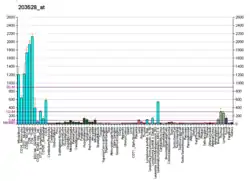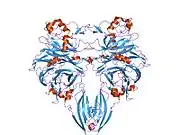Semaphorin-4D (SEMA4D) also known as Cluster of Differentiation 100 (CD100), is a protein of the semaphorin family that in humans is encoded by the SEMA4D gene.[5]
Function
Semaphorin 4D (Sema 4D) is an axon guidance molecule which is secreted by oligodendrocytes and induces growth cone collapse in the central nervous system. By binding plexin B1 receptor it functions as an R-Ras GTPase-activating protein (GAP) and repels axon growth cones in both the mature central nervous system.[6]
In the immune system, CD100 binds CD72 to activate B cells and dendritic cells, though much about this interaction is still under investigation.[7][8]
During skin damage repairs, SEMA4D interacts with Plexin B2 on Gamma delta T cells to play a role in the healing process.[9]
See also
References
- 1 2 3 GRCh38: Ensembl release 89: ENSG00000187764 - Ensembl, May 2017
- 1 2 3 GRCm38: Ensembl release 89: ENSMUSG00000021451 - Ensembl, May 2017
- ↑ "Human PubMed Reference:". National Center for Biotechnology Information, U.S. National Library of Medicine.
- ↑ "Mouse PubMed Reference:". National Center for Biotechnology Information, U.S. National Library of Medicine.
- ↑ "Entrez Gene: SEMA4D sema domain, immunoglobulin domain (Ig), transmembrane domain (TM) and short cytoplasmic domain, (semaphorin) 4D".
- ↑ Ito Y, Oinuma I, Katoh H, Kaibuchi K, Negishi M (July 2006). "Sema4D/plexin-B1 activates GSK-3β through R-Ras GAP activity, inducing growth cone collapse". EMBO Reports. 7 (7): 704–9. doi:10.1038/sj.embor.7400737. PMC 1500830. PMID 16799460.
- ↑ Kumanogoh A, Watanabe C, Lee I, Wang X, Shi W, Araki H, Hirata H, Iwahori K, Uchida J, Yasui T, Matsumoto M, Yoshida K, Yakura H, Pan C, Parnes JR, Kikutani H (November 2000). "Identification of CD72 as a lymphocyte receptor for the class IV semaphorin CD100: a novel mechanism for regulating B cell signaling". Immunity. 13 (5): 621–31. doi:10.1016/S1074-7613(00)00062-5. PMID 11114375.
- ↑ Ishida I, Kumanogoh A, Suzuki K, Akahani S, Noda K, Kikutani H (August 2003). "Involvement of CD100, a lymphocyte semaphorin, in the activation of the human immune system via CD72: implications for the regulation of immune and inflammatory responses". Int. Immunol. 15 (8): 1027–34. doi:10.1093/intimm/dxg098. PMID 12882840.
- ↑ Deborah A. Witherden, Megumi Watanabe, Olivia Garijo, Stephanie E. Rieder, Gor Sarkisyan, Shane J.F. Cronin, Petra Verdino, Ian A. Wilson, Atsushi Kumanogoh, Hitoshi Kikutani, Luc Teyton, Wolfgang H. Fischer, Wendy L. Havran (August 2012). "The CD100 Receptor Interacts with Its Plexin B2 Ligand to Regulate Epidermal γδ T Cell Function". Immunity. 37 (2): 314–25. doi:10.1016/j.immuni.2012.05.026. PMC 3430606. PMID 22902232.
Further reading
- Bougeret C, Mansur IG, Dastot H, et al. (1992). "Increased surface expression of a newly identified 150-kDa dimer early after human T lymphocyte activation". J. Immunol. 148 (2): 318–23. doi:10.4049/jimmunol.148.2.318. PMID 1530858. S2CID 29224711.
- Hall KT, Boumsell L, Schultze JL, et al. (1996). "Human CD100, a novel leukocyte semaphorin that promotes B-cell aggregation and differentiation". Proc. Natl. Acad. Sci. U.S.A. 93 (21): 11780–5. Bibcode:1996PNAS...9311780H. doi:10.1073/pnas.93.21.11780. PMC 38135. PMID 8876214.
- Herold C, Elhabazi A, Bismuth G, et al. (1997). "CD100 is associated with CD45 at the surface of human T lymphocytes. Role in T cell homotypic adhesion". J. Immunol. 157 (12): 5262–8. doi:10.4049/jimmunol.157.12.5262. PMID 8955171. S2CID 36341775.
- Furuyama T, Inagaki S, Kosugi A, et al. (1997). "Identification of a novel transmembrane semaphorin expressed on lymphocytes". J. Biol. Chem. 271 (52): 33376–81. doi:10.1074/jbc.271.52.33376. PMID 8969198.
- Tamagnone L, Artigiani S, Chen H, et al. (1999). "Plexins are a large family of receptors for transmembrane, secreted, and GPI-anchored semaphorins in vertebrates". Cell. 99 (1): 71–80. doi:10.1016/S0092-8674(00)80063-X. PMID 10520995. S2CID 17386412.
- Elhabazi A, Delaire S, Bensussan A, et al. (2001). "Biological activity of soluble CD100. I. The extracellular region of CD100 is released from the surface of T lymphocytes by regulated proteolysis". J. Immunol. 166 (7): 4341–7. doi:10.4049/jimmunol.166.7.4341. PMID 11254687.
- Delaire S, Billard C, Tordjman R, et al. (2001). "Biological activity of soluble CD100. II. Soluble CD100, similarly to H-SemaIII, inhibits immune cell migration". J. Immunol. 166 (7): 4348–54. doi:10.4049/jimmunol.166.7.4348. PMID 11254688.
- Vikis HG, Li W, Guan KL (2002). "The Plexin-B1/Rac interaction inhibits PAK activation and enhances Sema4D ligand binding". Genes Dev. 16 (7): 836–45. doi:10.1101/gad.966402. PMC 186329. PMID 11937491.
- Granziero L, Circosta P, Scielzo C, et al. (2003). "CD100/Plexin-B1 interactions sustain proliferation and survival of normal and leukemic CD5+ B lymphocytes". Blood. 101 (5): 1962–9. doi:10.1182/blood-2002-05-1339. PMID 12406905.
- Strausberg RL, Feingold EA, Grouse LH, et al. (2003). "Generation and initial analysis of more than 15,000 full-length human and mouse cDNA sequences". Proc. Natl. Acad. Sci. U.S.A. 99 (26): 16899–903. Bibcode:2002PNAS...9916899M. doi:10.1073/pnas.242603899. PMC 139241. PMID 12477932.
- Izmailova E, Bertley FM, Huang Q, et al. (2003). "HIV-1 Tat reprograms immature dendritic cells to express chemoattractants for activated T cells and macrophages". Nat. Med. 9 (2): 191–7. doi:10.1038/nm822. PMID 12539042. S2CID 26145639.
- Love CA, Harlos K, Mavaddat N, et al. (2003). "The ligand-binding face of the semaphorins revealed by the high-resolution crystal structure of SEMA4D". Nat. Struct. Biol. 10 (10): 843–8. doi:10.1038/nsb977. PMID 12958590. S2CID 24468463.
- Giraudon P, Vincent P, Vuaillat C, et al. (2004). "Semaphorin CD100 from activated T lymphocytes induces process extension collapse in oligodendrocytes and death of immature neural cells". J. Immunol. 172 (2): 1246–55. doi:10.4049/jimmunol.172.2.1246. PMID 14707103.
- Gerhard DS, Wagner L, Feingold EA, et al. (2004). "The Status, Quality, and Expansion of the NIH Full-Length cDNA Project: The Mammalian Gene Collection (MGC)". Genome Res. 14 (10B): 2121–7. doi:10.1101/gr.2596504. PMC 528928. PMID 15489334.
- Deaglio S, Vaisitti T, Bergui L, et al. (2005). "CD38 and CD100 lead a network of surface receptors relaying positive signals for B-CLL growth and survival". Blood. 105 (8): 3042–50. doi:10.1182/blood-2004-10-3873. PMID 15613544.
- Conrotto P, Valdembri D, Corso S, et al. (2005). "Sema4D induces angiogenesis through Met recruitment by Plexin B1". Blood. 105 (11): 4321–9. doi:10.1182/blood-2004-07-2885. PMID 15632204.
- Basile JR, Afkhami T, Gutkind JS (2005). "Semaphorin 4D/Plexin-B1 Induces Endothelial Cell Migration through the Activation of PYK2, Src, and the Phosphatidylinositol 3-Kinase-Akt Pathway". Mol. Cell. Biol. 25 (16): 6889–98. doi:10.1128/MCB.25.16.6889-6898.2005. PMC 1190270. PMID 16055703.
- Lewandrowski U, Moebius J, Walter U, Sickmann A (2006). "Elucidation of N-glycosylation sites on human platelet proteins: a glycoproteomic approach". Mol. Cell. Proteomics. 5 (2): 226–33. doi:10.1074/mcp.M500324-MCP200. PMID 16263699.
- Nkyimbeng-Takwi EH, Chapoval SP (2011). "Biology and function of neuroimmune semaphorins 4A and 4D". Immunol. Res. 50 (1): 10–21. doi:10.1007/s12026-010-8201-y. PMC 3366695. PMID 21203905.
- Smith EP, Shanks K, Lipsky MM, DeTolla LJ, Keegan AD, Chapoval SP (2011). "Expression of neuroimmune semaphorins 4A and 4D and their receptors in the lung is enhanced by allergen and vascular endothelial growth factor". BMC Immunol. 12: 30. doi:10.1186/1471-2172-12-30. PMC 3118960. PMID 21595947.
- Shanks K, Nkyimbeng-Takwi EH, Smith EP, Lipsky MM, DeTolla LJ, Keegan AD, Chapoval SP (2013). "Neuroimmune semaphorin 4D is necessary for optimal lung allergic inflammation". Mol. Immunol. 56 (4): 480–7. doi:10.1016/j.molimm.2013.05.228. PMC 3783523. PMID 23911404.
External links
- SEMA4D+protein,+human at the U.S. National Library of Medicine Medical Subject Headings (MeSH)






